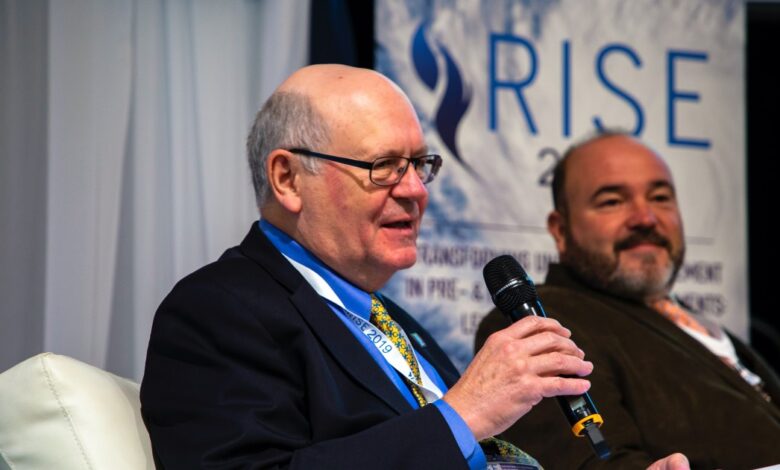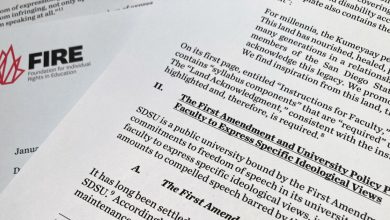A College President Says He Wants to Improve Governance. The Faculty Says He Wants to Destroy It.

Faculty members at the College of Staten Island were proud of their governance structure. It was progressive, they said, a bicameral design that featured both a Faculty Senate and a College Council that ensured staff members had a voice.
But now, that structure, and the principle of shared governance at their institution, is at risk, faculty leaders say. Staten Island’s president, William J. Fritz, has proposed a new governance plan that would eliminate both decision-making bodies in favor of a single entity that, critics say, would abrogate faculty input, with troubling implications for other City University of New York campuses and for higher education at large.
One faculty leader noted last month that the situation at Staten Island is “eerily similar” to those at eight institutions recently highlighted as problematic in the American Association of University Professors’ report on shared governance in the age of Covid-19.
“I really am befuddled by the president and other senior leaders’ taking such a dominant role in what’s supposed to be a shared-governance structure,” Neal Hutchens, a professor of higher education at the University of Mississippi, said in a Zoom meeting with Staten Island’s faculty leaders. Staten Island is one of the CUNY system’s 25 campuses, enrolls just under 12,000 students, and awards associate, bachelor’s, and master’s degrees.
Fritz’s plan was put to the college’s instructional staff for a vote and was resoundingly rejected, with 87 percent of voters opposed. That the referendum failed, faculty leaders say, is no surprise. But they’re not sure what will happen next. They fear that Fritz will submit his proposal to the CUNY Board of Trustees, despite provisions in the college’s bylaws that, they say, mean a failed referendum bars him from doing so. A spokesman for the college told The Chronicle that no decision had been made on how to proceed.
In an email on Monday announcing the results of the referendum, Fritz wrote that he would consider the vote alongside feedback from other constituents. “In my professional opinion,” he added, “it is clear that governance at the College of Staten Island needs to be improved.”
Fritz’s plan was meant to “foster a culture of collegiality, respect, and appreciation of the different perspectives inherent in different constituencies,” David Pizzuto, the college’s interim director of communications and marketing, said in a statement to The Chronicle. “The plan encourages participation from those who might not have had the opportunity to participate before, allows for inclusion of staff that were historically excluded from campus governance, ensures more voices are heard, and most importantly, creates a supportive environment for our students.” It would also “conform to best practices in higher education” and ensure the college complied with accreditation standards, Pizzuto said.
The CUNY system did not immediately respond to a request for comment late Friday.
Faculty members, though, see it differently. They point out that the governance debate followed a vote of no confidence in Fritz and the provost, J. Michael Parrish, in December. It’s not hard, faculty leaders say, to draw a connection between the no-confidence vote and the new governance plan, which Fritz announced in March. It was, the leaders say, a retaliatory measure.
Nor is it a coincidence that Fritz’s plan would eliminate the Faculty Senate, which issued the no-confidence vote, said Cindy Hing-Yuk Wong, a former chair of that body. She said Fritz’s attempt to rewrite the governance rules was a way to shield himself from criticism.
Jane Marcus-Delgado, Wong’s successor as Faculty Senate chair, took it one step further. “I’m a Latin Americanist. I study coups d’état and people who overturn governments,” Marcus-Delgado said. “That’s what he was doing.”
Simmering Frustrations
The vote of no confidence arose from years of faculty frustration, John Verzani, a professor of mathematics and the chair of the College Council, said. “There was really no smoking gun,” he said, but financial mismanagement and a raft of departures — 35 faculty members left the college in the 18 months preceding the no-confidence vote — contributed to the consternation.
“The president, frankly, I think, was just really tired of dealing with a lot of the people who were in charge, even though we had been re-elected by the faculty year after year,” Marcus-Delgado said. So he and other administrators “decided that they were going to see if they could find a way not to have to deal with us.”
So morale was low when Fritz’s governance plan “hit like a ton of bricks,” as Marcus-Delgado put it. Some things at the college had not been working, but faculty governance was not among them. Verzani said that during his time as chair of the bylaws committee, he’d received just a handful of proposals to modify the governance plan. “It was definitely not a festering conversation that the college wanted to have.”
Fritz isn’t a newcomer trying to make his mark on campus. He’ll soon celebrate 10 years at the helm at Staten Island, having been appointed interim president in 2012 and named to the post permanently in 2014. Before that, he spent four years as the college’s provost. So he knows how governance has traditionally operated there, faculty leaders say, and in the past has worked within those structures.
Though Fritz’s plan underwent several rounds of revisions before voting began at the end of September, faculty leaders told The Chronicle that its substance was really unchanged. Before the referendum, chairs of 18 of the college’s 24 departments released a statement urging the instructional staff to reject the plan.
Fritz’s proposal “remained a living document from the time it was introduced to the time it was voted on last week,” Pizzuto said. “There were many revisions and several drafts, reflecting the feedback and suggestions of the campus community, which were shared throughout the process. Feedback and dialogue has been welcomed throughout the process and continues to be encouraged.”
‘A Pretty Obvious Power Grab’
What exactly does Fritz’s plan propose? It would replace the Faculty Senate and College Council with a “College Senate” headed by the president. Some standing committees would be eliminated, and others would be led by an administrator or have administrators among the membership, which could deter junior faculty members, in particular, from expressing their opinions, faculty leaders say.
For a president to lead a governance body, and to have such a primary role in setting the agenda, seems to subvert “the notion, in some ways, of how shared governance is supposed to function,” Hutchens, the higher-education professor, said during the Zoom meeting. It’s not uncommon for university administrators to hold ex officio posts in faculty governance, he added, but those roles are often nonvoting. A setup like the one Fritz proposes, he added, could find top officials voting, as governance members, on proposals they put forth as administrators.
“If you don’t have the faculty running those committees, someone else is going to set that agenda,” on matters like the curriculum, hiring and firing, faculty composition, and program cuts, Marcus-Delgado said. “Those are all things that we have input on now. If the president is running all of these committees and our governing bodies are all dissolved, a lot of this stuff will not be brought to the table.”
The AAUP’s New York State conference concurred, in a letter sent to Fritz and faculty leaders on September 28. “The proposed governance plan systematically eliminates several standing committees such as collegewide budget, bylaws, and institutional planning with the stated intent to replace these when deemed necessary with ad hoc committees selected by the president,” the state conference’s leaders wrote. “This is counter to recommendations of the AAUP to ensure faculty involvement at all times in such activities with properly elected faculty representatives.”
The plan amounts to “a pretty obvious power grab,” George Emilio Sanchez, chair of the college’s department of performing and creative arts and of its chapter of the CUNY Professional Staff Congress, a union.
“He’s made assertions about governance plans that make them seem like they’re the sole prerogative of the president as long as he can get board approval, that there’s no need to consult with stakeholders, that he’s not bound by the results of a referendum, that he is obliged to do what he thinks is right,” Verzani added. “Not what his administration thinks is right, not what those stakeholders think is right. Just what he thinks is right.”
High Stakes
As president, Fritz was within his rights — if not following convention — to present his governance plan for a referendum. But what he doesn’t have the right to do, his critics say, is forward it to the CUNY system’s board now that it has been rejected by faculty members. For an amendment to the college’s governance structure to be passed, the current governance plan states, it must be approved by the instructional staff via a referendum as well as by the president and the system board.
The stakes of Fritz’s next step couldn’t be higher, Jason Bishop, a linguistics professor and member of the Faculty Senate, said. “If the bylaws aren’t binding,” he said, “and a president has absolute power to disregard them when he chooses, what can’t he do?”
Sanchez, the union leader, said the best-case scenario for critics of Fritz’s plan would involve Fritz’s resignation. The president could also choose not to send the proposal to the board, or to negotiate his plan through existing channels, a possibility that faculty leaders said they’d welcome.
Otherwise, Sanchez and Marcus-Delgado said, they’re prepared to battle Fritz’s plan at a higher level.
“We’re going to fight like hell,” Marcus-Delgado said. “I think that it’s up to us to hold these administrators’ feet to the fire and to not let this pass.”
Source link






